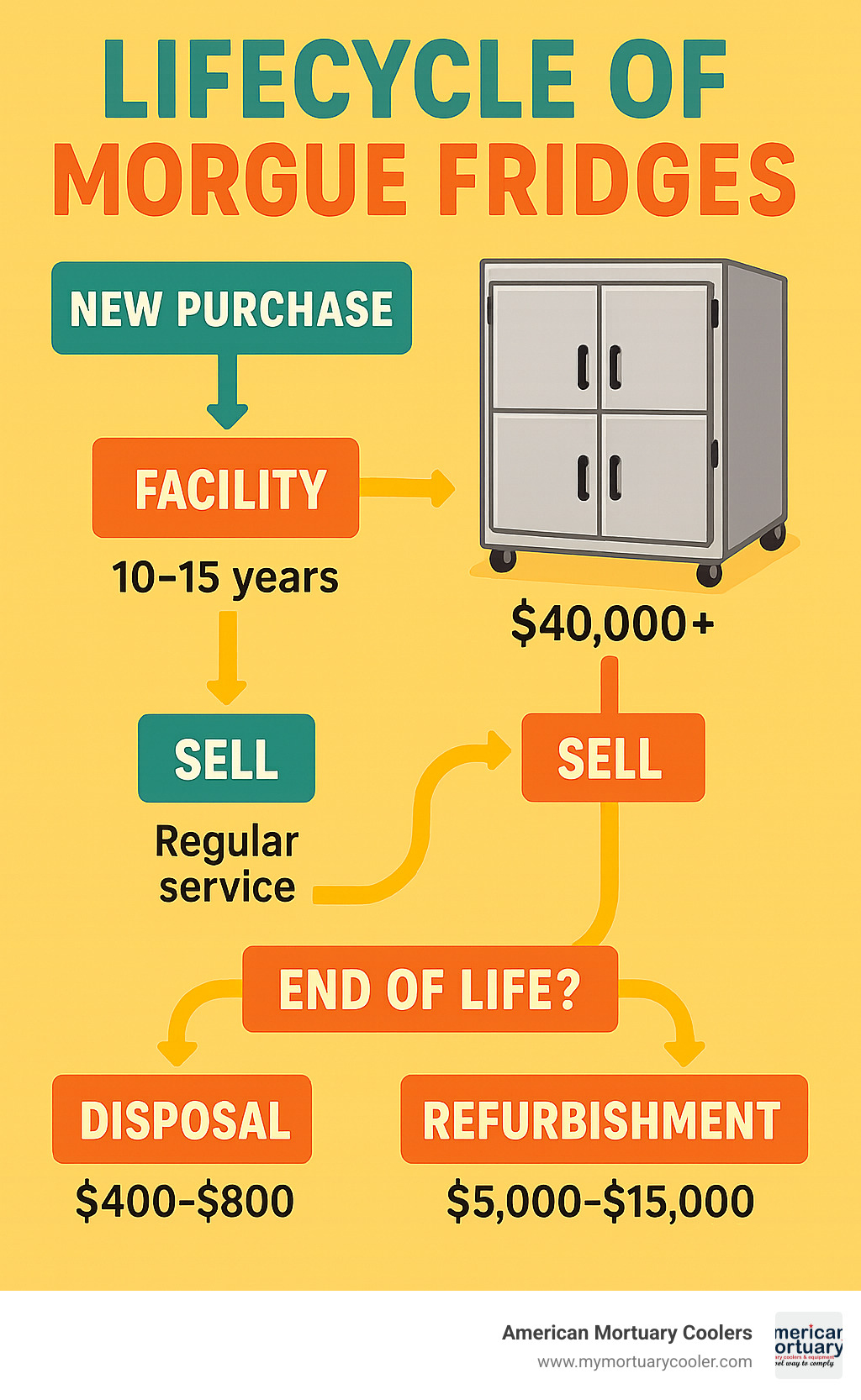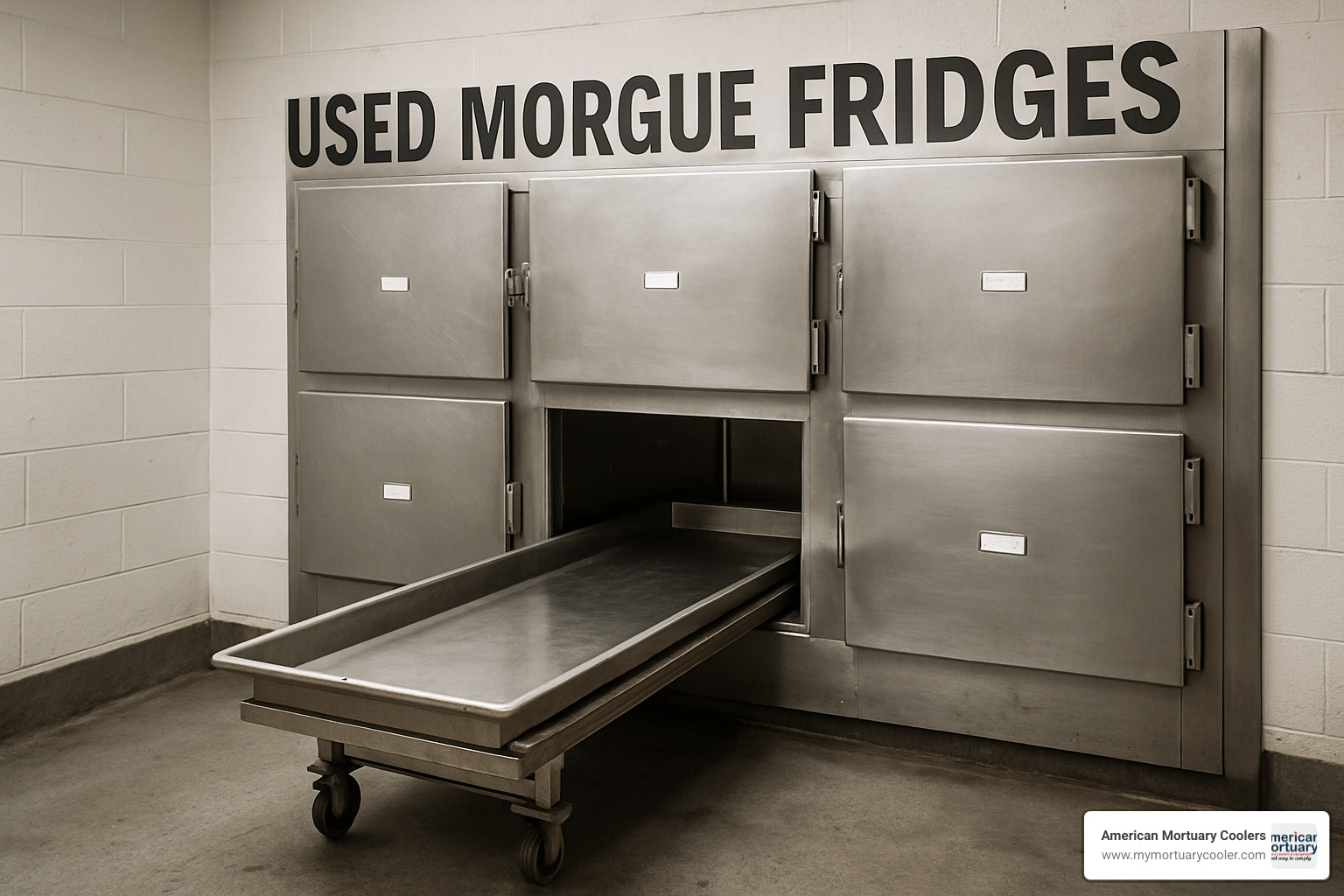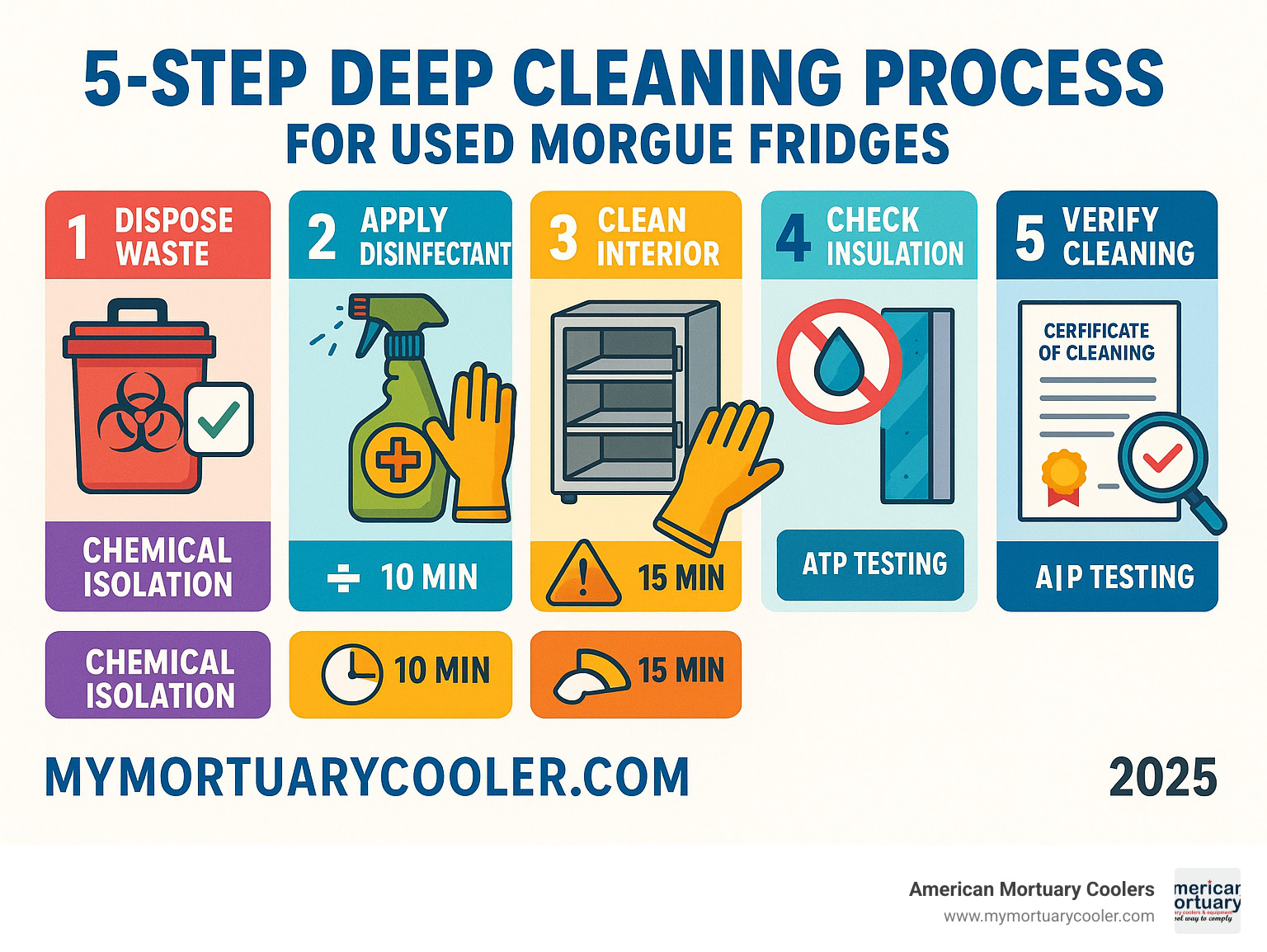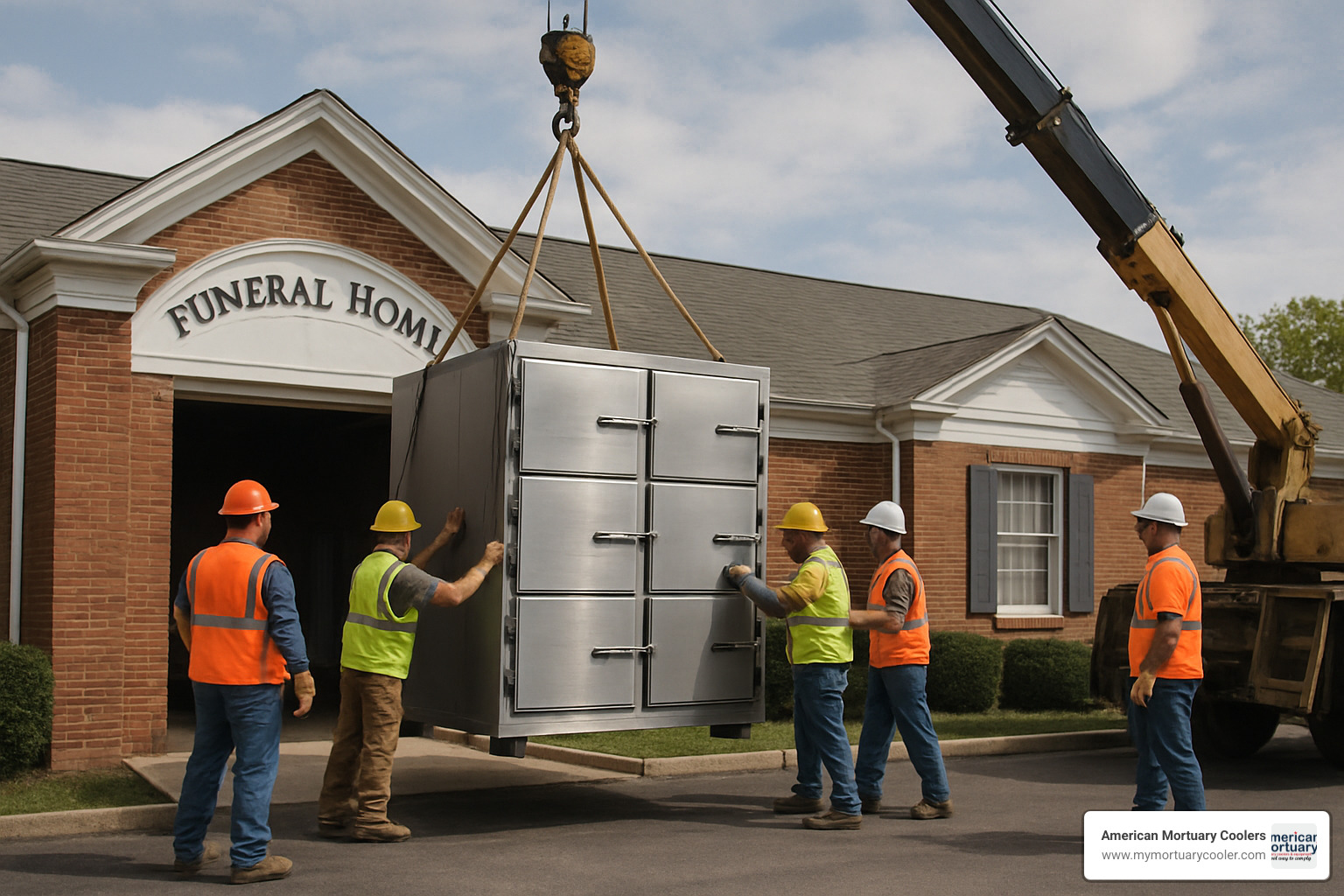Why Used-Morgue-Fridges Are Worth Considering for Your Facility
Used-morgue-fridges offer funeral homes and mortuaries a cost-effective path to essential refrigeration equipment, typically saving 40-70% compared to new units while providing reliable service for 10-15 years when properly maintained.
Quick Overview: Used Morgue Fridge Essentials
- Price Range: $1,600 - $6,000 (vs. $53,591 for new 2-body units)
- Common Capacities: 2-body, 3-body, 4-body, 6-body, and 8-12 body units
- Temperature Classes: Positive (2°C to 4°C) and Negative (-10°C to -50°C)
- Expected Lifespan: 10-15 years with proper maintenance
- Warranty: Typically 30 days to 1 year (limited coverage)
- Key Materials: 304/316 stainless steel with 80mm polyurethane insulation
Equipping a funeral home can strain any budget, which is why many directors turn to second hand mortuary fridges as a smart alternative.
Beyond immediate cost savings, choosing used equipment contributes to sustainability by reducing manufacturing demand and extending the useful life of quality refrigeration units. However, success depends entirely on thorough inspection, proper documentation, and understanding what to look for before you buy.
I'm Mortuary Cooler, a national-level mortuary cooler supplier with extensive experience helping funeral homes steer the used-morgue-fridges market. My background includes evaluating hundreds of pre-owned units and guiding facility directors through the inspection process to ensure they get reliable equipment that serves their needs for years to come.

What Are Used-Morgue-Fridges? Types, Capacities & Temperature Classes
When we talk about used-morgue-fridges, we're referring to pre-owned refrigeration units that were specifically built to store human remains in funeral homes, hospitals, and morgues. These aren't your typical commercial refrigerators – they're precision-engineered units designed to maintain exact temperatures that slow decomposition and preserve bodies during identification, autopsy, or burial preparation.
There's a real difference between "refurbished" and "pre-owned" units. Refurbished equipment has been through a professional restoration process – think component replacement, deep cleaning, and thorough testing. Pre-owned units are sold "as-is" from their previous location.
The world of morgue refrigeration breaks down into two main temperature classes:
Positive temperature units operate between 2°C to 4°C (about 36°F to 39°F). These don't stop decomposition completely, but they slow it significantly – extending storage time from days to weeks. These are the workhorses of the funeral industry and represent the majority of used-morgue-fridges you'll find on the market.
Negative temperature units run much colder, from -10°C to -50°C (14°F to -58°F). These actually freeze bodies to minimize decomposition and are primarily used in forensic institutes or for long-term storage situations.
The range runs from compact 2-body units perfect for smaller funeral homes all the way up to large 8-12 body walk-in coolers for high-volume facilities. The sweet spot for many operations falls somewhere in the middle with 3-body, 4-body, or 6-body units that balance storage needs with space constraints.
Key Ways Used-Morgue-Fridges Differ from New Models
Depreciation has already done its work on used units, which is great news for your budget. A new 3-body unit might cost you $58,614 to $69,758, but that same unit in good used condition could be yours for $2,500 to $4,500.
Energy efficiency in older models might not match the latest technology, but most used-morgue-fridges from the last decade still operate efficiently with proper maintenance.
Warranty coverage is where used units show their limitations. New equipment typically comes with comprehensive manufacturer warranties, while used units offer limited coverage. Private sellers usually offer "as-is" sales, refurbishers might provide 30 to 90 days of coverage, and equipment dealers sometimes offer 6 to 12 months on certified pre-owned units.
Customization options are limited with used equipment since you're working with existing configurations. The trade-off is immediate availability – used equipment is typically ready to ship, unlike new units that may require weeks or months for manufacturing and delivery.
Popular Sizes of Used-Morgue-Fridges
2-body units are the compact champions of the used market. They fit into tight spaces and represent excellent entry-level options for smaller operations. These are often your most affordable used option, with prices starting around $1,600.
3-body units hit the sweet spot for many funeral homes. They offer good capacity without taking up excessive space, and they frequently appear in the used market as facilities upgrade to larger capacity.
6-body units are the high-capacity cabinet-style units that maximize storage in a relatively compact footprint. These are popular among busy funeral homes that need substantial storage capacity but don't have the space for walk-in units.
Bariatric units deserve special mention because they're designed for larger individuals. These specialized oversized units are less common in the used market, but they offer essential capability for facilities serving diverse populations.
Modular walk-in units represent the large-capacity end of the spectrum. What makes these particularly attractive in the used market is their modular design – they can be disassembled and relocated, then reconfigured for new locations.

Pricing, Budget & Cost-Benefit Analysis
Let's talk numbers – because that's probably why you're here. Used-morgue-fridges deliver impressive savings of 40-70% compared to new equipment, with most units falling in the $1,600 to $6,000 range. That's a significant difference when you consider new 2-body units start around $53,591.
The pricing sweet spot varies based on several key factors. Age and condition play the biggest role – a well-maintained 5-year-old unit will cost more than a 15-year-old model showing wear. Brand reputation matters too, with established names like Mopec and Thermo Fisher holding their value better than lesser-known manufacturers.
Features and technology can bump up prices significantly. Units with advanced temperature controls, comprehensive alarm systems, or energy-efficient components command premium pricing. The seller type also influences cost – equipment dealers and certified refurbishers typically charge more than private sellers, but they often throw in better documentation and limited warranties.
Here's how the math works out in real terms:
| Factor | New Unit | Used Unit | Advantage |
|---|---|---|---|
| Purchase Price | $53,591 (2-body) | $1,600-$3,000 | 65-70% savings |
| Warranty | 5-15 years | 30 days-1 year | New wins |
| Payback Period | N/A | Immediate | Used wins |
| Carbon Footprint | High (manufacturing) | Low (reuse) | Used wins |
For more detailed information about finding great deals, check out our cool deals guide.
The depreciation mathematics work beautifully in your favor. New equipment loses substantial value the moment it's installed – that painful first-year depreciation hit. Used-morgue-fridges have already absorbed this financial blow, meaning a quality used unit often retains its value better than a new purchase over the first few years.
Operating costs deserve honest consideration. Older units might not match the energy efficiency of brand-new models, but here's the reality: the savings from lower purchase prices typically outweigh higher utility bills for many years. A properly maintained used unit can serve reliably for 10-15 years, making the total cost of ownership very attractive.
Financing options exist for used mortuary equipment through many equipment financing companies. The approval process is often faster than for new equipment purchases. Tax considerations can also work in your favor – used equipment may qualify for different depreciation schedules that benefit your bottom line. It's worth having a conversation with your accountant about the best approach for your specific situation.
One interesting aspect many buyers overlook: you're also contributing to sustainability by extending equipment life and reducing manufacturing demand. It's a win-win situation that saves money while being environmentally responsible.
For context about the importance of proper refrigeration, you might find it interesting to learn about what hospital morgues really smell like when equipment isn't functioning properly.
The bottom line? Used-morgue-fridges offer compelling financial advantages, especially when you factor in immediate availability and proven reliability. Just make sure you do your homework on inspection and documentation – which we'll cover in detail next.
Pre-Purchase Inspection & Compliance Checklist
Getting a used-morgue-fridges inspection right can make the difference between a smart purchase and an expensive headache. Think of it like buying a used car – you wouldn't drive off the lot without popping the hood first.
The inspection process starts with structural integrity. Walk around the unit and look for obvious damage like cracks, dents, or rust spots. Pay extra attention to the door frames and hinges since these take the most abuse over time. A few cosmetic scratches are normal, but deep cracks or significant rust can signal bigger problems down the road.
Next, focus on the insulation system. Most quality morgue fridges use 80mm thick polyurethane insulation, which is critical for maintaining stable temperatures. Look for water stains, discoloration, or any signs that moisture has gotten into the insulation. Once insulation gets saturated, it's usually game over – the unit will struggle to maintain temperature and your energy bills will skyrocket.
Door gaskets deserve special attention because they're often the first thing to fail on older units. Run your hand along the magnetic seals checking for cracks, tears, or areas where the gasket has lost its shape. A good seal should feel firm and springy. Damaged gaskets aren't necessarily a deal-breaker since they can be replaced, but factor the cost into your negotiations.
The compressor run-test is where things get serious. Ask the seller to demonstrate the unit running through a complete cooling cycle. Listen for unusual noises, vibrations, or grinding sounds that could indicate mechanical problems. The unit should reach and maintain its set temperature within reasonable time frames.
Temperature accuracy is non-negotiable in this business. Bring a calibrated thermometer and verify that the display matches actual internal temperatures within ±1°C. Test the alarm functions too – you need to know if something goes wrong, especially during weekend or overnight storage.
Don't forget about compliance standards. The unit should meet UL 471 requirements for commercial refrigeration, OSHA workplace safety standards, and any local health department codes. If the seller has ISO 9001 documentation, that's a good sign they've maintained quality standards throughout ownership.
10-Point On-Site Inspection Before You Pay
Here's your final walkthrough checklist before money changes hands. This systematic approach has saved countless buyers from expensive surprises:
Visual inspection comes first – examine every surface for cracks, especially around stress points like door corners and mounting brackets. Insulation moisture signs include water stains, rust streaks, or musty odors that suggest the unit has been compromised.
Check that tray rails slide smoothly and lock securely in position. Bent or damaged rails can cost hundreds to replace and make daily operations frustrating. Condenser coils should be relatively clean – dirty coils often indicate poor maintenance habits by the previous owner.
The electrical panel should look professional with proper labeling and no signs of amateur repairs or burn marks. If the unit has a data logger, ask to see recent temperature records. Consistent performance over time is exactly what you want to see.
Decontamination status matters more than you might think. Find out what cleaning has already been done and what you'll need to handle yourself. Request any available maintenance records – these documents tell the real story of how well the unit has been cared for.
Verify the serial plate information matches all paperwork and check for any liens or ownership disputes. Finally, listen to the noise level during operation. Excessive noise often signals mechanical problems that may not be immediately obvious.
Hygiene, Decontamination & Documentation Essentials
Let's be honest – buying used-morgue-fridges means dealing with equipment that has served a very specific purpose. Proper decontamination isn't just about cleanliness; it's about ensuring your facility meets health standards and your staff feels confident using the equipment.
ATP swab testing provides scientific proof of cleanliness by detecting biological residue that visual inspection might miss. This adenosine triphosphate testing gives you objective data about the unit's sanitary condition.
Professional disinfectants designed specifically for mortuary equipment should be used throughout the decontamination process. This includes all interior surfaces, drainage systems, and those hard-to-reach corners where residue tends to accumulate.
Always request a certificate of cleaning from the seller. If they can't provide one, budget for professional decontamination services before installing the unit in your facility. It's worth the extra cost for peace of mind.
Maintenance logs are like medical records for the equipment. They reveal patterns of care, recurring problems, and help predict future service needs. Look for evidence of regular coil cleaning, gasket replacements, and temperature calibration – all signs of responsible ownership.

For additional guidance on finding quality second-hand units, visit our comprehensive guide to finding second-hand mortuary fridges.
Delivery, Installation & Ongoing Maintenance
Getting your used-morgue-fridges from "sold" to "serving your families" requires careful planning. I've seen too many facilities rush this process, only to face expensive delays or installation headaches that could have been easily avoided.
Planning Your Delivery Path: Before that truck arrives, grab a tape measure and walk the entire path from your loading dock to the final installation spot. These units are substantial – we're talking about equipment that often weighs 800-1,500 pounds and measures 6-7 feet in height.
Measure every doorway, hallway turn, and ceiling clearance along the route. Pay special attention to elevator dimensions if you're installing on an upper floor.
Shipping and Handling Options: Most used-morgue-fridges ship either crated or with blanket wrap protection. Crated units offer superior protection during transport but require forklift access for unloading. Unless you have a loading dock, you'll need lift-gate service.
The 24-Hour Rule: Once your unit arrives, let it stand upright for 24 hours before plugging it in. This settling period allows the refrigerant and compressor oil to return to their proper positions after horizontal transport. Skipping this step can damage the compressor and void any warranty coverage.
Electrical Considerations: Most units operate on either standard 110V or 208-230V power. Check your facility's electrical capacity against the unit's requirements before delivery day.
Initial Setup and Testing: Once your unit has settled and you've connected the power, run it empty for 24 hours while monitoring temperature stability. Use an independent thermometer to verify the built-in display accuracy.
Creating Your Maintenance Routine: The secret to getting 10-15 years of reliable service from used-morgue-fridges lies in consistent preventive maintenance. Your routine should include quarterly coil cleaning to maintain energy efficiency – dirty coils force the compressor to work harder and drive up electricity costs.
Monthly gasket inspections catch small problems before they become expensive repairs. A torn door seal might seem minor, but it can increase energy consumption by 20-30% while compromising temperature stability.
Weekly temperature verification with an external thermometer ensures your unit maintains proper storage conditions. Don't rely solely on the built-in display – independent monitoring protects both your reputation and your families' trust.
Annual professional service by a qualified technician catches potential issues early and keeps your warranty valid. This service typically includes refrigerant level checks, electrical connection inspection, and calibration verification.
Understanding Warranty Limitations: Unlike new equipment with comprehensive coverage, used units typically offer limited warranties ranging from 30 days to 1 year. Understand exactly what's covered – some warranties only cover major components like compressors, while others exclude labor costs entirely.
Parts and Service Planning: Before you need them, identify reliable suppliers for common replacement parts. Door gaskets, temperature sensors, and control components are the most frequently replaced items.
Realistic Lifespan Expectations: With proper maintenance, quality used-morgue-fridges typically provide 10-15 years of reliable service. This longevity, combined with the substantial upfront savings, makes used equipment an excellent investment for most facilities.

Frequently Asked Questions about Used Morgue Fridges
When you're considering used-morgue-fridges, these three questions come up consistently in our conversations with funeral directors and facility managers. Let me give you the honest answers you need to make informed decisions.
Do used units come with any warranty?
The warranty situation with used-morgue-fridges is honestly all over the map, and it largely depends on who you're buying from.
If you're dealing with private sellers – maybe a funeral home upgrading their equipment – you'll typically get an "as-is" sale with zero warranty protection. The upside? You'll usually pay the lowest possible price. The downside? You're completely on your own if something goes wrong the day after delivery.
Certified refurbishers take a middle-ground approach. They'll often provide 30-90 days of limited coverage on major components like compressors and temperature controls. This isn't comprehensive protection, but it does give you some breathing room to identify any serious problems.
Equipment dealers who specialize in pre-owned mortuary equipment sometimes offer 6-12 month warranties on their certified units. Yes, you'll pay more upfront, but this coverage can be invaluable if you don't have extensive technical expertise on your team.
Here's something many buyers don't think to ask about: transferable manufacturer warranties. Some newer used units may still have remaining coverage from the original purchase. Always ask sellers about warranty status and request documentation if any coverage exists.
How can I verify temperature accuracy before purchase?
Temperature accuracy isn't something you want to find problems with after you've already paid and installed the unit. Here's how to verify performance before you commit.
Bring your own calibrated thermometer to compare readings with the unit's built-in display. Don't rely solely on what the digital readout tells you. Acceptable variance is typically within ±1°C, so anything beyond that should raise red flags.
Ask the seller for recent temperature logs or service records. If they've been maintaining proper documentation, you'll see evidence of consistent temperature maintenance over time. This historical data is often more valuable than a single-moment reading.
If possible, monitor the unit over several hours during your inspection. Open and close the doors a few times, then watch how quickly temperatures recover. Test whether alarm functions activate at the right temperature thresholds – you'll definitely want those working properly.
For high-value purchases, consider hiring a qualified refrigeration technician for a pre-purchase inspection. Their trained eye can spot potential problems that might not be obvious to someone without technical background. The inspection fee is usually worth it when you're making a significant investment.
What are the biggest risks of buying sight-unseen?
I'll be straight with you – buying used-morgue-fridges without seeing them in person can turn what looks like a great deal into an expensive headache. Here are the biggest risks you're taking.
Undisclosed structural damage tops the list of serious concerns. Cracks in insulation panels or refrigeration lines might not show up clearly in photos, but they can make a unit completely unrepairable. We've seen buyers find major structural problems only after the unit arrives.
Unknown decontamination status creates both health risks and regulatory compliance issues. The unit might need extensive professional cleaning that wasn't mentioned in the listing, adding hundreds or even thousands to your actual cost.
Misrepresented condition happens more often than you'd expect in online sales. Sometimes sellers genuinely don't understand the technical aspects of what they're selling. Other times, they're deliberately downplaying problems to attract buyers.
Electrical or dimensional incompatibilities can prevent installation even when the unit works perfectly. You might find the electrical requirements don't match your facility, or the unit won't fit through your doorways.
Shipping damage becomes a much bigger risk with distance and handling complexity. Used units rarely have the original protective packaging that was designed for safe transport.
Hidden mechanical faults are particularly frustrating because they might not show up during a brief demonstration, but cause failures shortly after you've installed the unit.
You can reduce these risks by requesting detailed photos and videos from multiple angles, doing thorough documentation review before committing, using buyer protection through established marketplaces when possible, and arranging professional pre-purchase inspection for valuable units.
The bottom line? If you can possibly arrange to see the unit in person, do it. The peace of mind is worth the travel time and expense.
Conclusion & Next Steps
Choosing used-morgue-fridges can be one of the smartest financial decisions for your funeral home or mortuary. With savings of 40-70% compared to new units, you're looking at keeping thousands of dollars in your budget while still getting reliable equipment that can serve families with dignity for 10-15 years.
The secret sauce? Don't cut corners on inspection. I can't stress this enough – spending a few hundred dollars on a professional evaluation can save you thousands in unexpected repairs. Think of it as insurance for your investment.
Your thorough inspection isn't just about avoiding problems. It's about ensuring families receive the respectful care they deserve during their most difficult moments. A properly maintained used unit can provide the same level of service as new equipment, just at a fraction of the cost.
There's also something satisfying about the environmental benefit. By choosing used equipment, you're extending the life of quality manufacturing and reducing waste. It's a small but meaningful way to operate more sustainably in an industry that's increasingly conscious of its environmental impact.
Of course, used equipment isn't the perfect fit for everyone. If you're just starting out without maintenance experience, need highly specific customizations, or require comprehensive warranty protection, new equipment might make more sense for your situation.
At American Mortuary Coolers, we understand that sometimes used options simply can't meet your facility's unique requirements. When that happens, we're here to craft custom mortuary coolers that fit your exact needs. Based in Tennessee, we deliver our purpose-built solutions across all 48 contiguous states.
Whether you go used or new, the goal remains the same – reliable refrigeration that honors families and supports your daily operations without breaking your budget.
For comprehensive information about all mortuary cooling solutions, visit our main website. Ready to explore custom options custom specifically for your facility? Request a quote today and find how our custom solutions can address your unique challenges.
The used-morgue-fridges market offers genuine opportunities for smart buyers. With proper inspection, realistic expectations about warranty coverage, and a commitment to ongoing maintenance, you can secure quality equipment that serves your community for years to come while keeping capital available for other important facility improvements.



















